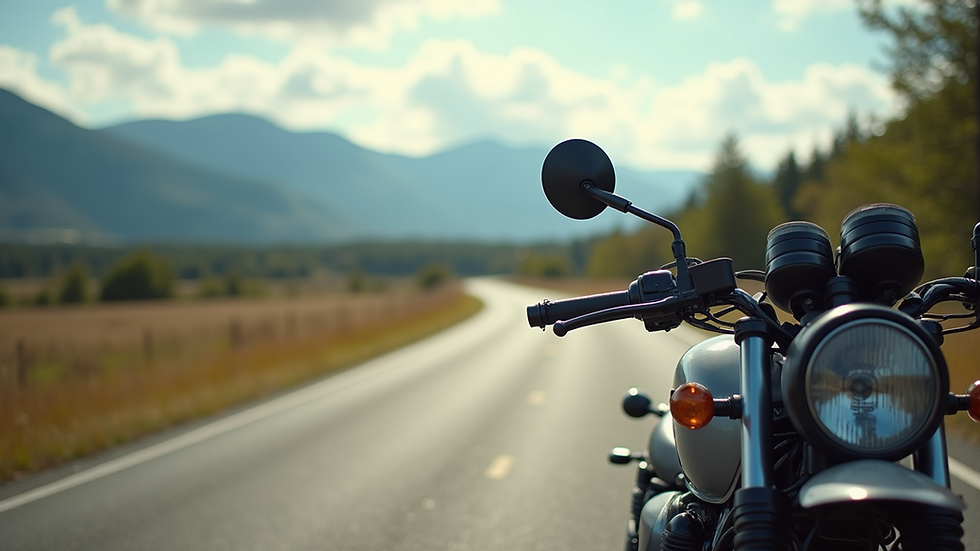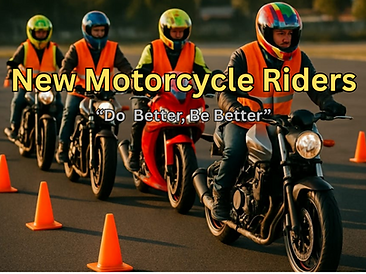Choosing the Ideal First Motorcycle for New Riders: A Comprehensive Guide
- NMR

- Aug 9
- 4 min read
Buy Once, Cry Once: This is a saying some people use to convince an inexperienced rider to purchase a motorcycle that they are not ready for. Economically it makes sense, but if the motorcycle is too much for you it may be the first and last motorcycle you buy. We want you to have a long, happy riding experience. By buying a motorcycle that you can handle and better learn on, you will only be increasing your odds of learning how to control a motorcycle better and faster. You can always buy another motorcycle, but you only have one life.

Motorcycling is not just a mode of transport; it’s an adventure filled with freedom and excitement. For new riders, finding the right first motorcycle can be overwhelming due to the numerous options available. Making the right choice is crucial for ensuring a safe and enjoyable experience. This guide will help you understand the different types of motorcycles, engine sizes, safety features, and more, enabling you to make an informed decision.
Understanding Motorcycle Types
Choosing the right type of motorcycle is essential for aligning with your riding style. Below are popular categories to consider:
Cruiser Motorcycles
Cruisers are known for their low seats and relaxed riding positions, which makes them beginner-friendly. Brands like Harley-Davidson and Honda offer models like the Harley-Davidson Street 500 and Honda Rebel 500, both featuring smooth torque delivery that’s easier for new riders to handle. Cruisers typically have engine capacities ranging from 250cc to 750cc.
Sport Bikes
Sport bikes prioritize speed and agility, often boasting aggressive riding positions. While models like the Kawasaki Ninja 400 and Yamaha YZF-R3 are enticing, their high power can be daunting for novices. It’s best to select a smaller displacement sport bike—ideally under 500cc—to build confidence without feeling overwhelmed.
Standard Motorcycles
Standard motorcycles, or naked bikes, offer a balanced riding experience. Models like the Yamaha MT-03 and Kawasaki Z400 combine comfort with versatility. Their upright seating position makes them ideal for new riders who want a good all-rounder for daily use and casual rides.
Adventure and Dual-Sport Bikes
Thanks to their design for both on and off-road use, adventure bikes like the Kawasaki Versys-X 300 and Honda CRF250L are versatile options. However, they tend to have taller seat heights, which might be challenging for shorter riders. Still, they are perfect for those interested in exploring diverse terrains.
Dirt Bikes
If you prefer a less intimidating environment for learning, consider starting with a dirt bike, like the Honda CRF250F. These lightweight models are specifically designed for off-road riding, allowing you to master essential skills before transitioning to street bikes.
Engine Size Matters
The engine size of a motorcycle significantly impacts its performance. For beginners, it is advisable to range between 250cc and 500cc.
Why Smaller Engines?
Bikes with smaller engines provide controlled power delivery, allowing you to develop your skills without becoming overwhelmed. For example, a 300cc bike can help you gain confidence, with many new riders easily mastering on-road handling within a few weeks.
Consider Your Riding Style
Think about how you plan to use the motorcycle. If you primarily commute or take short rides, a smaller engine is often sufficient. However, if highway riding is part of your plan, you might consider a bike in the 400cc to 500cc range for added power.
Safety Features to Look For
Safety should always come first. When selecting a motorcycle, keep these features in mind:
Anti-lock Braking System (ABS)
ABS is vital for preventing wheel lock-up during emergency braking, enhancing your control. Many newer models, like the Kawasaki Ninja 300, come equipped with ABS, making them safer options for beginners.
Traction Control
Traction control aids in preventing wheel spin, particularly in wet conditions. This is especially useful for new riders still developing throttle control, reducing the chance of skidding.
Lightweight Design
Opt for lighter motorcycles, as they are generally easier to balance and maneuver. For example, bikes like the KTM 390 Duke weigh around 340 lbs, making them much easier for new riders during low-speed handling.
Comfort and Fit
Finding a bike that fits your body is key to comfort and confidence. Consider the following:
Seat Height
Ensure you can comfortably reach the ground with both feet when seated. This will make starting and stopping much easier, giving you confidence. A seat height between 30 to 32 inches is often ideal for most new riders.
Riding Position
Riding positions can vary widely. Sit on several models to discover your comfort level. Some may prefer an upright position offered by standards, while others may prefer the more aggressive stance of sport bikes.
Test Riding
Always test ride potential motorcycles before making a decision. This experience will help you evaluate the bike’s handling and comfort. Here are key tips:
Wear Proper Gear
Wearing the right gear, including a helmet, gloves, and durable clothing, is crucial. It will keep you safe and provide insights into how the bike feels at speed.
Take Your Time
Don’t rush the test ride. Spend adequate time exploring how the bike reacts to turning, braking, and acceleration. This helps build a connection with the motorcycle.
Ask Questions
Inquire about the motorcycle’s maintenance history and features. Understanding the bike’s background will aid in making a well-informed decision.

Budget Considerations
Budget is a vital component of your motorcycle journey. Alongside the purchase cost, account for insurance, maintenance, gear, and fuel.
New vs. Used
Purchasing new motorcycles often guarantees the latest technology and warranties, albeit at a higher cost. Used motorcycles can be more economical but require thorough inspections. Look at a used Kawasaki Ninja 300, which can range from $4,000 to $5,000, compared to a new model likely costing over $5,500.
Insurance Costs
Insurance can vary based on the motorcycle's model and your riding experience. Before buying, gather quotes to ensure your choice fits within your budget.
Final Thoughts on Your Motorcycle Journey
Finding your ideal first motorcycle is not just about selecting a bike; it can shape your riding experience for years. By understanding motorcycle types, engine sizes, and safety features, and prioritizing comfort and fit, new riders can make an informed choice.
Take your time, test ride different models, and be mindful of your budget. With the right motorcycle, you’ll be equipped to enjoy the unmatched freedom and thrill of riding. Happy riding!





.png)



Comments